Traditional Vietnamese dishes captivate with their blend of simplicity, complexity, and profound cultural significance. From the savory depths of pho to the refreshing bite of fresh spring rolls, each dish tells a story of Vietnam’s history, geography, and community. The vibrant color palettes, the harmonious balance of flavors, and the abundant use of fresh herbs and vegetables mark Vietnamese cuisine as both healthful and an exhibition of culinary artistry. Whether enjoyed at roadside stalls, in bustling markets, or during festive family gatherings, these dishes offer more than nourishment they provide a taste of Vietnamese cultural heart and soul.
Essential Vietnamese Dishes
In exploring essential Vietnamese dishes, one appreciates the subtle interplay between legacy and innovation. These dishes, including the iconic pho, the ubiquitous banh mi, the flavorful bun cha, the delicate goi cuon, and the satisfying com tam, offer a vivid depiction of Vietnamese culinary practices. Each dish brings together elements of flavor and tradition, reflecting the influences of neighboring countries and past colonial occupations, while firmly holding onto distinct local flair. Recognizing their roots and variations paves the way for understanding the broader narrative of Vietnamese cuisine.
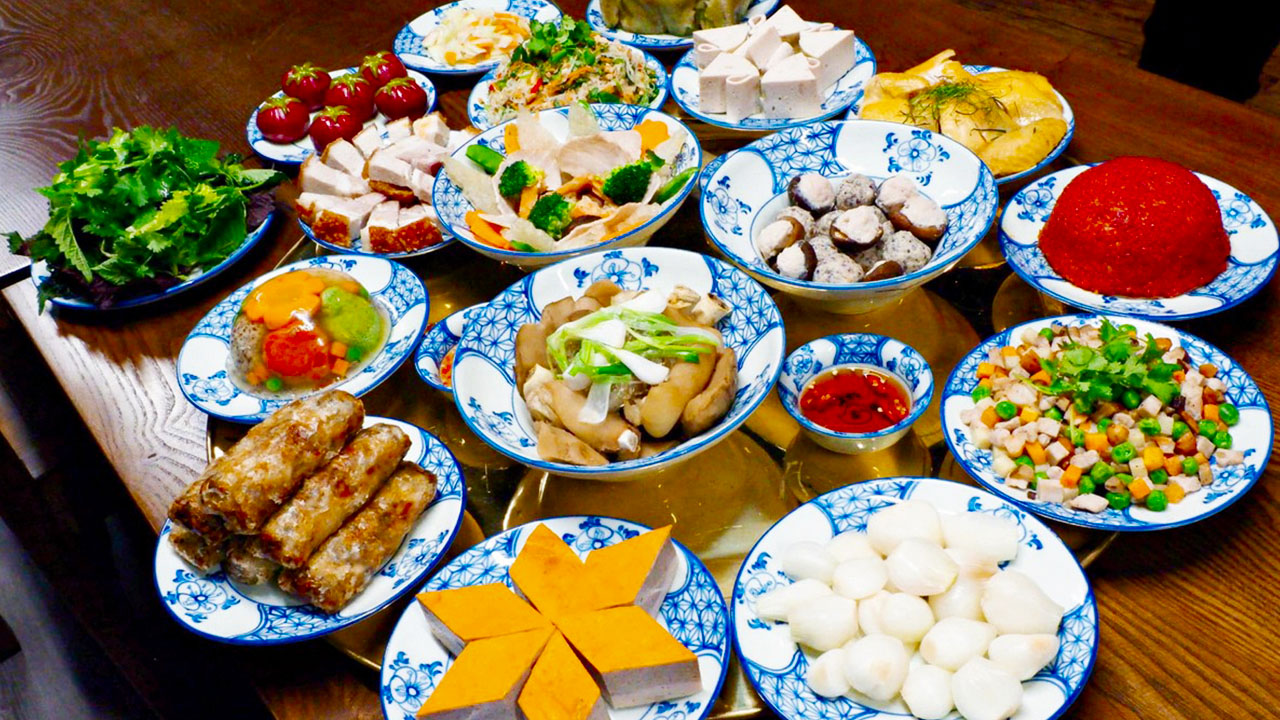
Pho: The National Dish of Vietnam
Pho stands out as a national emblem in the realm of Vietnamese cuisine. It captures Vietnam’s culinary identity with its rich, aromatic broth, a symphony of complex flavors that have been simmered to perfection with bones and spices like star anise and cinnamon. Each spoonful carries a robust essence that acts as a bridge between Vietnam’s past and its vibrant present. The delicate noodles, bánh phở, floating effortlessly in the broth, are reminiscent of Vietnam’s enduring grace and simplicity amidst its diverse cultural history.
The character of pho subtly shifts from the north to the south of Vietnam. While Northern Pho prides itself on a clear and simple broth, allowing the beef or chicken’s intrinsic flavors to captivate the palate, Southern Pho indulges in a sweeter and richer variant, embellished with more garnishes and a wider range of herbs. This regional diversity within a single dish underscores the country’s geographical and cultural breadth.
- Northern Pho (Pho Bac):
- Clear, minimalist broth
- Fewer garnishes
- Highlights beef or chicken subtly
- Southern Pho (Pho Sai Gon):
- Richer, sweeter broth
- Extensive herbs and condiments
- More vibrant presentation
Pho is not merely a dish; it’s a tapestry of memories, a communal experience that binds the people of Vietnam together in shared heritage and culinary delight. Its aroma wafts through morning air in bustling street stalls, turning breakfast into a ritual of family and friends savoring their histories and everyday lives.

Banh Mi: A Fusion of Cultures
In the heart of Vietnamese culinary innovation lies Banh Mi, a sandwich that epitomizes cultural fusion and adaptability. Emerging during the French colonial period, this iconic street food marries the crusty texture of the French baguette with robust Vietnamese flavors. Banh Mi is not merely a sandwich; it is a reflection of historical confluence, where European breadmaking techniques merge with Southeast Asian ingredients.
A standard banh mi features a variety of elements, creating a juxtaposition of textures and tastes:
- Core Ingredients:
- Crusty French baguette base
- Grilled or roasted meats like pork or chicken
- Layer of pate adding richness
- Accompaniments:
- Pickled vegetables such as carrots and daikon
- Fresh herbs, including cilantro and basil
- Creamy mayonnaise or spicy chili sauce for an additional kick
The magic of Banh Mi comes from the balance of these ingredients, with each bite offering an orchestra of flavors sweet, sour, salty, and spicy. Its global popularity has spawned countless variations, with each culture around the world adding a unique twist to this beloved dish. Nevertheless, the soul of the original banh mi remains distinctly Vietnamese.
Whether purchased from a bustling Saigon street vendor or enjoyed in an upscale restaurant, banh mi continues to be a testament to Vietnam’s rich tapestry of cultural interactions and culinary adaptability.

Bun Cha: Traditional Hanoi Cuisine
Bun Cha, a dish that perfectly embodies Hanoi’s local flavor, is a classic Vietnamese delight. Each portion presents robust, savory grilled pork, often accompanied by patties or slices of marinated belly pork, and served with a refreshing heap of rice vermicelli. This combination of flavors is tied together with a nuoc cham dipping sauce that melds sweetness, saltiness, and acidity into a harmonious sip.
In each flavorful mouthful of Bun Cha, there’s a journey through Hanoi’s street markets where the smoke from grills mixes with the aroma of fresh herbs. Prepared traditionally, the pork derives its rich taste from being marinated in a blend of fish sauce, sugar, and spices, offering a culinary experience that is both rustic and sophisticated. Bun Cha leaves a smoky yet sweet trail on the palate, contrasting with the vermicelli’s softness and the herbs’ fresh zest.
The dish stands apart with its straightforward assembly yet profound complexity:
- Grilled Pork:
- Juicy meatballs and smoky pork belly
- Marinated to perfection
- Rich, robust flavor
- Accompaniments:
- Vermicelli noodles offering a subtle counterbalance
- A medley of fresh herbs
- Spicy, sweet, and sour nuoc cham sauce
The intrigue of Bun Cha lies in its balance of components, making it not only a staple lunchtime dish but a beloved affair between flavors and textures. It reflects Hanoi’s knack for transforming simple ingredients into iconic culinary experiences.

Goi Cuon: Fresh Spring Rolls
Goi Cuon, often called fresh spring rolls or summer rolls, captures an exquisite balance of healthfulness and taste within its translucent rice paper. These rolls, packed with poached shrimp, crispy pork slivers, light vermicelli noodles, and an array of fresh herbs, stand as a testimony to Vietnam’s culinary prowess where simplicity meets artistry.
In crafting Goi Cuon, layers of Vietnamese cuisine unfold. Each roll brims with vibrant notes; the savory meat filling contrasts against the crispness of cucumbers and the aromatic push of mint or cilantro. Traditionally served with a dipping sauce like peanut hoisin or the vibrant nuoc cham, fresh spring rolls exhibit that extra zest which elevates the humble ingredients to heights of culinary joy.
- Primary Fillings:
- Poached Shrimp
- Pork Belly
- Vermicelli Noodles
- Accompaniments:
- Crisp lettuce, aromatic herbs like mint, basil, and cilantro
- A choice of peanut-hoisin or nuoc cham for dipping
These fresh spring rolls are a culinary epitome of simplicity. Unlike their fried counterpart, cha gio, these rolls shine in their fresh state, making them a light, health-giving option for any meal or occasion. They evoke a sense of gathering; families traditionally prepare and enjoy Goi Cuon together, sharing not only food but camaraderie and joy.

Com Tam: The Delicacy of Broken Rice
Central to Vietnam’s culinary landscape is Com Tam, or broken rice a dish that exemplifies both economy and elegance. Originating from humble beginnings, broken rice was once considered inferior, reserved for those who could not afford the whole grain. However, in the heart of Ho Chi Minh City and beyond, Com Tam has achieved legendary status, celebrated as a cornerstone meal, especially in the south.
In preparation, the broken grains offer a unique texture, providing a softer chew while retaining the distinctive aroma of Jasmine rice. Com Tam is typically served with grilled pork, known as Suon, often accompanied by bi (shredded pork skin) and cha, a savory steamed egg and pork cake, creating a delightful culinary mosaic.
Some common accompaniments include:
- Grilled Pork Chop (Suon):
- Marinated to tenderness
- Smoky and flavorful
- Egg Meatloaf (Cha):
- A blend of beaten egg and minced pork
- Steamed to perfection
- Pickled Vegetables and Fresh Herbs
- Provide a tangy, aromatic contrast
Com Tam serves as comfort food par excellence, with each plate offering a taste of daily Vietnamese life. It embodies a perfect blend of flavors and textures: the rich, smoky notes of grilled pork dancing elegantly with the soft, fragrant rice underneath. Consumed in bustling market corners or as the main entree in homely feasts, Com Tam highlights the transformative power of Vietnamese cuisine, turning the ordinary into something truly extraordinary.

Popular Variations of Vietnamese Dishes
Vietnamese cuisine is celebrated for its diversity, where even the most iconic dishes evolve regionally, resulting in a dynamic culinary landscape. Pho, a quintessential essential Vietnamese dish, demonstrates these regional nuances brilliantly, while banh mi’s shifting fillings reflect cultural variations. Goi Cuon wraps change as per local produce availability, and each com tam pairing resonates with the locale. A closer examination of these dishes uncovers the intricate weave of Vietnamese flavors across different regions.

Regional Differences in Pho
The regional distinctions in pho provide a flavorful exploration of Vietnam’s diverse culinary tapestry. At its heart, pho is a harmonious blend of broth, beef or chicken, and rice noodles, but its character shifts dramatically as one travels from North to South Vietnam. Each region adds its own signature twist, interpreting pho through local spices and traditions.
Northern Pho (Pho Bac), particularly found in Hanoi, embodies a minimalist ethos. Its broth is clear and delicate but packed with depth from marrow-rich beef bones and a precise concoction of star anise, cloves, and cinnamon. Minimal garnishes allow the broth to sing, offering imbibers a chance to experience the soul of each ingredient in its purest form.
- Typical Characteristics:
- Clear, understated broth
- Fewer herbs and garnishes
- Focus on high-quality ingredients
Southern Pho (Pho Sai Gon), on the other hand, is a celebration of abundance. The broth is richer, sweeter, thanks to the addition of rock sugar, complemented by a plethora of fresh herbs, including basil and cilantro, and a wide array of condiments, such as hoisin sauce and sriracha. The experience is one of vibrant, layered flavors that dance on the palate in complex harmony.
- Typical Characteristics:
- Rich, sweet, nuanced broth
- Many herbs and condiments available
- Flavorful toppings like meatballs and tripe
Thus, pho’s regional variation is akin to a culinary dialect the fundamental notes remain constant, but the expression is very much of its place. It’s not just about flavor and aroma but a representation of cultural identity and regional pride. Wandering through Vietnam exploring different pho styles would be akin to taking a gastronomic tour through distinct cultures, each uniquely Vietnamese yet wonderfully varied.

Types of Banh Mi Fillings
Banh Mi is synonymous with versatility in Vietnamese cuisine, built on a foundation of fresh, crusty baguettes, and filled with an array of delectable ingredients that reflect both personal preference and cultural influences. Each variation of banh mi is a unique expression of Vietnam’s adaptability, offering a culinary canvas ripe for innovation and tradition alike.
Classic Banh Mi revolves around the savory delight of marinated meats most notably pork in its many forms, from belly to roast. Chicken, beef, and tofu also make frequent appearances in modern takes, pleasing a range of palates from carnivores to vegetarians.
- Core Fillings:
- Pate and Butter
- Grilled Pork (Thịt Nướng) or Chicken
- Tofu for Vegetarian Variants
Freshness is critical, facilitated by a variety of vibrant vegetable accompaniments the pickled carrots and daikon bring a crisp tang, while cucumber slices add refreshing texture. Combined with herbs like cilantro and the gentle heat of red chili, each banh mi is a complex interplay of flavor and texture.
- Essentials:
- Pickled Vegetables for tartness and crunch
- Fresh Herbs for aroma and flavor balance
- Various Sauces to enhance depth
What enables Banh Mi to capture hearts globally is this ability to adapt, each variant offering a new taste journey while reflecting the sandwich’s roots in confluence. Whether purchased from street vendors or crafted in upscale eateries, each banh mi remains an ode to Vietnam’s historical integration between East and West, repurposing French heritage into a distinctly Vietnamese narrative.

Variations of Goi Cuon Ingredients
The refreshing Goi Cuon is an artful encapsulation of Vietnamese simplicity and flair, presenting multiple variations based on region and personal preference. Each element of these fresh spring rolls offers a unique contribution, painting a vibrant picture of Vietnam’s commitment to fresh, balanced eating.
The filling traditionally comprised of poached shrimp or sliced pork provides a tender, protein-rich cornerstone. However, regions and seasons bring in their own delightful modifications. Various options ensure a goi cuon aligns with both dietary needs and the availability of ingredients at hand.
- Traditional Elements:
- Shrimp and Pork for savory and protein-rich content
- Noodles and Lettuce for lightness and texture
Modern interpretations see tofu and avocados being embraced by vegetarians, bringing in creaminess and nutritional benefits. The impact of local produce sees an influx of fresh cucumbers, basil, mint, and other herbs, ensuring each bite sings a fresh tune.
- Common Refreshers:
- Mint, Basil, Cilantro for refreshing aromatic
- Cucumber for crispness
With dipping sauces, such as spicy, tangy nuoc cham or a rich, nutty peanut-based sauce, goi cuon becomes more than the sum of its parts it’s a ritual of combining fresh, vibrant flavors with just the right extras for enhancing consumer pleasure. The beauty of goi cuon lies in its variability, encouraging exploration and personal culinary expression while paying homage to Vietnamese tradition.

Com Tam Pairings and Accompaniments
Com Tam, or broken rice, offers a robust foundation for a variety of complementary pairings that enhances its appeal as a quintessential Vietnamese meal. Recognized by its distinct chipped rice grains, com tam provides a unique textural palate unmatched by other rice dishes.
The traditional com tam ensemble typically includes grilled meat often pork chops marinated to tenderness and imparting a smoky note that complements the rice’s softness. Shredded pork skin, known as bi, and cha trung, an egg meatloaf, introduce savory layers, while a fresh fried egg, cucumber slices, and pickled vegetables complete the dish with a harmonious blend of flavors and textures.
- Pork Options:
- Grilled Pork Chops for smoky richness
- Shredded Pork Skin for tender, savory contrast
- Essential Accompaniments:
- Pickled Vegetables for tart crunch
- Fresh Herbs and Cucumber Slices for freshness
- Fried Egg for richness
At its core, the charm of com tam lies in its adaptability, capturing both humble origins and gourmet presentation. As it remains malleable to different cultural and regional influences, com tam embodying a culinary openness that is one of Vietnam’s defining traits an unyielding ability to evolve while retaining authenticity.

Cooking Techniques in Vietnamese Cuisine
Vietnamese dishes, characterized by their vibrant flavors, owe much to meticulous cooking techniques that spotlight natural ingredients and balance. From pho’s long-simmered broth to banh mi’s crusty bread, each technique reflects a finely-tuned culinary art. Whether it involves grilling for bun cha or choosing between steaming and frying for goi cuon, cooking methods are pivotal in delivering the essence of Vietnamese cuisine. These techniques not only bring out the best in each dish but ensure that tradition embraces adaptability, showcasing a seamless blend of flavors, textures, and aromas.

Broth Preparation for Pho
The perfect Pho flavor stems largely from the meticulous preparation of its broth a pillar of Vietnamese culinary art. This labor-intensive process begins with roasting onions, shallots, and ginger; their caramelization lays the foundation for flavorful complexity. Meanwhile, beef bones simmer in large pots for hours, releasing deep flavors and collagen, crucial for capturing Pho’s rich, irresistible broth.
Discerning Pho experts know that careful skimming of impurities during simmering ensures broth clarity. Then, aromatics like star anise and cloves are added, infusing the liquid with gentle spice. If an orchestra had a flavor, it would be this rich and harmonious broth, achieved through passionate dedication and time.
- Key Ingredients for Pho Broth:
- Beef Bones for umami depth
- Caramelized Onions and Ginger for warmth
- Aromatic Spices for balance
A wise addition of fish sauce at the end enhances flavor without clouding the broth; detail work like this underscores the mastery behind this simple-yet-complex soup that winds its way into the hearts and kitchens globally. Each steaming bowl represents a slice of daily Vietnamese life, ready to nurture and bring people together.

The Art of Making Banh Mi Bread
The creation of an exceptional Banh Mi bread a unique Vietnamese take on the traditional French baguette is an art form that marries traditional baking techniques with a touch of local flair. With its light, crispy crust and airy interior, the ideal Banh Mi baguette is a delicate dance between technique, precision, and proper ingredient selection.
The initial step involves creating dough from a carefully measured blend of flour, glucose-rich water, yeast, and, occasionally, rice flour to impart a distinct tenderness. After an extensive kneading process, the dough rests to allow for flavor enhancement through fungal fermentation, embodying the microbial dance responsible for its signature rich flavor and airy consistency.
- Essential Bread Ingredients:
- Wheat Flour and Water for airy texture
- Yeast for ideal fermentation
- Rice Flour (optional) for additional flavor note
Upon crafting and shaping, the dough undergoes a rising period in warm conditions, after which the shaped baguettes are baked in steam-filled ovens at high temperatures. This fierce heat, paired with steam, crisps the bread’s outer layer but leaves its core satisfyingly tender a hallmark of any authentic Banh Mi sandwich. The final product is both a canvas for the kaleidoscope of flavors within and a vehicle of taste and texture that elevates simple fillings into the realm of haute cuisine.
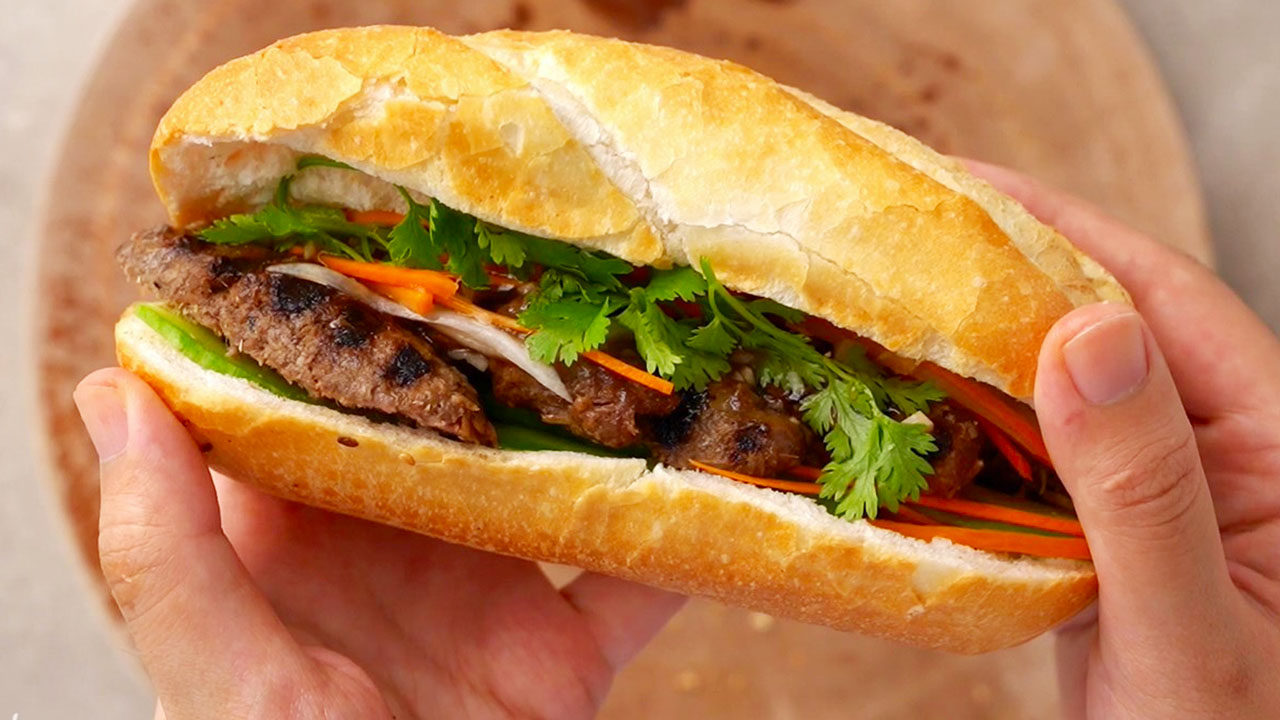
Grilling Techniques for Bun Cha
Within Bun Cha, the heart rests on the expert grilling techniques that lend the dish its depth of flavor and irresistibly smoky aroma. Pork, central to the dish, is often marinated first allowed to luxuriate in a bath of lemongrass, garlic, and fish sauce before taking center stage on a sizzling charcoal grill. The grill’s method, a mix of art and science, results in those delightfully charred and crispy edges that contrast with the pork’s juicy interior.
The intricacy lies in watching the whole process diligently, ensuring that the meat’s cooked just right. A skilled chef uses nudges of flame and temperatures to caramelize the marinade without overcooking the pork.
- Grilling Process:
- Charcoal for smoky infusion
- Lemongrass and Garlic Marinade for fragrant complexity
- Skillful Grilling for char and tenderness
This vibrant smoky essence, in balance with the tangy dipping sauce of fish sauce, sugar, and vinegar, celebrates Vietnam’s values of simplicity and harmony in its culinary constructs. A dish like Bun Cha showcases the role technique plays in drawing out and intensifying flavors across textures.

Steaming vs. Frying: Cooking Goi Cuon
Goi Cuon, historically called fresh or summer rolls, showcase the dynamic cooking techniques in Vietnamese cuisine, contrasting with the popular fried cha gio. The technique for creating Goi Cuon highlights the importance of rice paper pliancy and the reliance on fresh ingredients for taste and appeal.
Steaming, a traditionally used method in Goi Cuon preparation, maintains the food’s nutrients and unblemished textures. The rice paper is soaked until pliable, wrapping with precision and care around the fresh layers of herbs, vegetables, and protein such as shrimp and pork. However, some variants employ a quick fry, adding a crispy outer layer resembling the richer cha gio.
- Steaming Approach:
- Retains freshness and texture
- Softer, lighter outcome
- Frying Approach:
- Adds crispiness and warmth
- Richer, more indulgent option
With a dipping sauce on the side, whether peanut-based or vibrant nuoc cham, Goi Cuon highlight the versatility within Vietnamese culinary art, allowing diners to choose based on mood or dietary preference. Each method offers unique flavors and experiences, emphasizing the importance of cooking technique in dictating culinary expression.

Nutritional Aspects of Vietnamese Dishes
Examining cooking techniques deeply enriches understanding of popular Vietnamese dishes’ nutritional profiles. Traditional methods like broths and grilling not only ensure flavor and texture optimization but also preserve and enhance nutritional values. Vibrant vegetables, lean meats, and herbal infusions make these cuisine highlights both delicious and beneficial, reflecting a culture that values sustenance and flavor balance. This nutritional depth takes the local culinary experience to global appreciation and recognition, cementing its place as a healthful culinary choice.
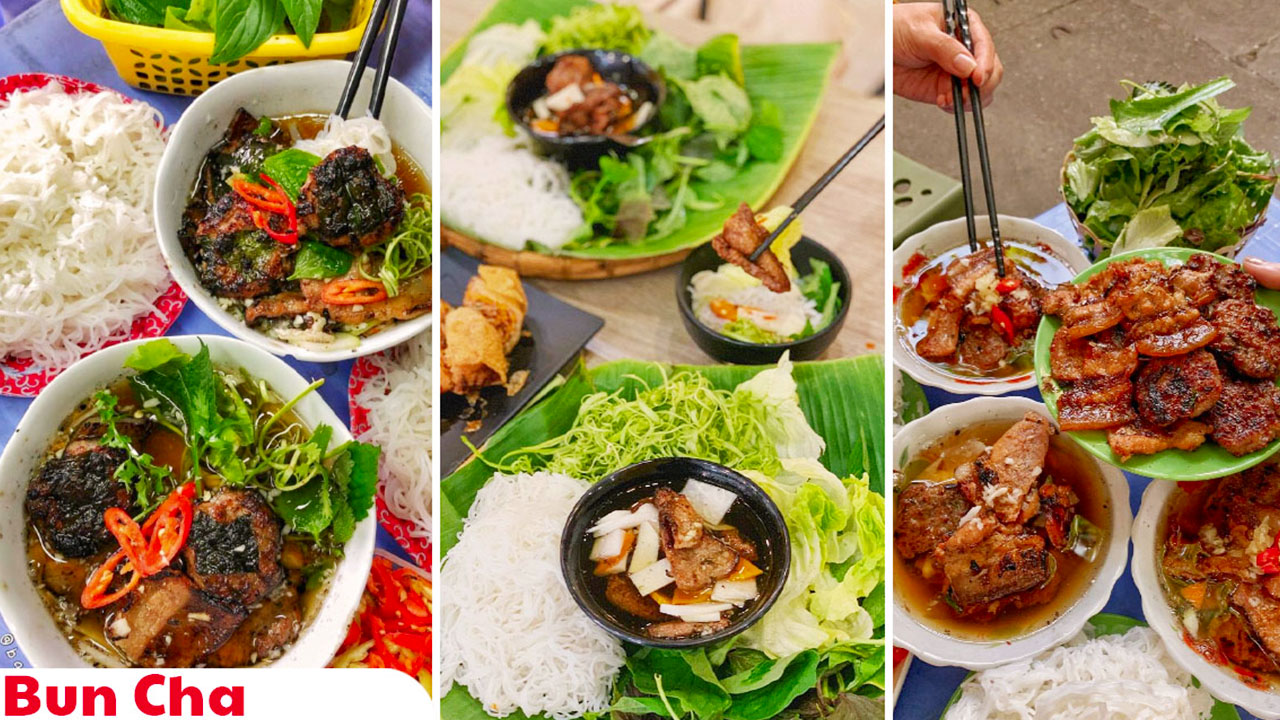
Health Benefits of Pho
Pho stands as a bastion of health within Vietnamese cuisine, offering a rich canvas of nutrients teeming within its brothy depths. The powerhouse of this dish lies in its broth, traditionally boiled from beef bones, drawing out collagen that benefits joint lubrication and skin elasticity.
This infusion includes a blend of herbs like cilantro and basil, known for their antioxidants and anti-inflammatory properties. Their regular consumption contributes to sustained health benefits and protection against free radicals.
Another significant aspect is pho’s inclusion of lean proteins, predominantly beef or chicken, but extending to tofu for vegetarian variations. These sources deliver essential amino acids vital for tissue repair and muscle maintenance.
- Nutritional Components:
- Collagen-rich broth supports joints
- Lean proteins for essential amino acids
With calorie counts averaging between 350-500 calories per bowl, pho offers a satiating yet weight-friendly option. Rarely doused in fat, the dish maintains its health appeal by balancing taste and nutrition, providing an accessible meal that fuels the body and soul alike.

Nutritional Value of Bun Cha
Delving into Bun Cha, the delicate balance of flavors meets a thoughtfully structured nutritional profile. The dish, centralized on grilled pork, provides high-quality protein essential for muscle growth and repair. This is complemented by starchy vermicelli noodles a complex carbohydrate that ensures extended energy release.
Fresh herbs and leafy greens, typical in Bun Cha, enhance the defense against oxidative stress, contributing an array of vitamins such as vitamin C and K, and dietary fiber for digestive wellness.
- Key Ingredients:
- Grilled Pork for protein strength
- Vermicelli Noodles for carbohydrates
- Nutrient Enhancers:
- Fresh Herbs for vitamins and fiber
Despite its savory profile, Bun Cha is relatively low in sodium, primarily moderated by its light application of fish sauce, a crucial factor for maintaining cardiovascular health. Each component of Bun Cha is chosen to feed the body not solely for energy but for vitality, ensuring diners are as enriched nutritionally as they are gastronomically.
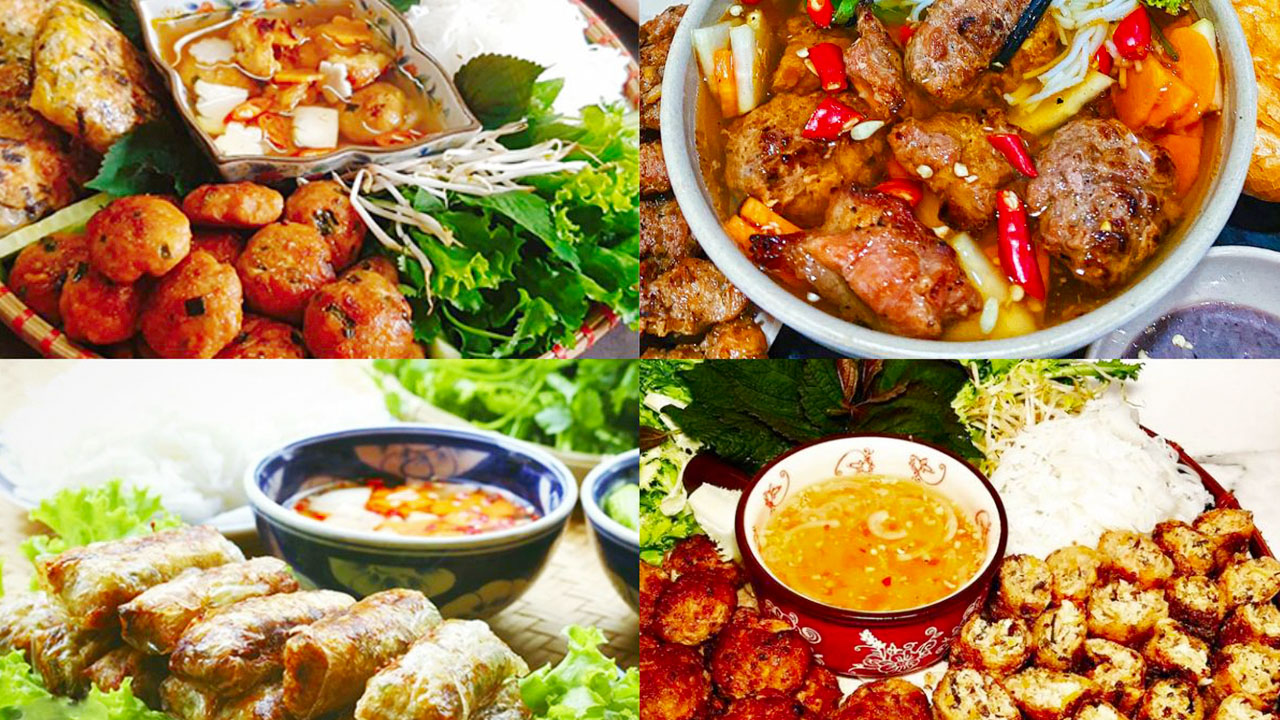
Ingredients That Make Goi Cuon Healthy
Goi Cuon offers a tapestry of nutritional benefits through its embrace of vibrant, natural ingredients, making it one of the healthiest appetizers in Vietnamese cuisine. The filling’s primary component of shrimp or pork provides lean protein, crucial for bodily repair and muscle maintenance. Meanwhile, the abundance of fresh, green herbs like mint, basil, and cilantro furnish high levels of vitamins and antioxidants.
A cornerstone of Goi Cuon’s health profile is the use of vermicelli noodles; light and versatile, they contribute soluble fiber aiding digestion. This fiber richness is further enhanced by the crunchy vegetables carrots, cucumbers, and bell peppers that add not only layers of flavor but fiber and essential vitamins.
- Nutrient Powerhouses:
- Shrimp/Pork for lean protein
- Fresh Herbs for vitamins and antioxidants
- Textural Complements:
- Vermicelli Noodles for fiber boost
- Assorted Vegetables for nutrition
With a dipping sauce typically comprising of fish sauce or peanut-based dressing, the subtle sweetness and spice elevate Goi Cuon’s experience, contributing additional flavors without overwhelming its inherent healthfulness. Sociable and flavorsome, Goi Cuon is a culinary choice that satiates without compromising wellness.

Com Tam: Caloric and Nutritional Profile
Com Tam’s status as a pinnacle meal in Vietnamese cuisine doubles with its thoughtful caloric balance and nutritional depth, highlighting broken rice’s adaptability. The grilled pork chops or shredded pork skin furnish ample protein, necessary for energy sustenance and muscle function.
Incorporating a mosaic of vegetables, the dish enhances fiber content, promoting digestive efficiency while packing in vitamins like A, C, and K. The richness of the fried egg top adds a buttery texture to the meal and an extra dose of healthy fats.
- Caloric Breakdown:
- Grilled Pork for muscle-focused energy
- Vegetables for fibers and vitamins
- Nutritional Enhancers:
- Fried Egg for fats
- Broken Rice for unique texture
With diverse toppings and pickled vegetables rounding this out the tanginess balances every bite Com Tam thrives as a thoroughly nourishing and satisfying meal. While often found on bustling streets, its significant health credentials elevate it to a meal where nostalgia meets practicality an ode to Vietnam’s mastery of harmonizing taste with nutrition.

Street Food Culture in Vietnam
Vietnam’s street food culture captivates with a vibrant array of flavors stemming from its nutrition-rich vegetarian dishes to succulent meat delights. The accessible diversity empowers diners to savor the health that navigates beyond just nutrition to embrace gusto and connection. Aspiring local vendors showcase artistry and innovation, inviting exploration on every corner. Ultimately, street food traditions illuminate the ever-evolving culinary scene, rich in history and imbued with cultural pride, proving that Vietnamese cuisine doesn’t only feed the body it nourishes the spirit.

Popular Street Food Vendors for Pho
When seeking the true heart of Pho, Vietnam’s bustling streets whisper tales of age-old recipes served piping hot. Iconic vendors like Pho Bat Dan in Hanoi await dawn-breakers for a taste of history, where locals unite over steaming bowls, reveling in aromatic broths steeped with beef bones. Bathed in authenticity, this cherished vendor merges nostalgia with flavor excellence, beckoning everyone to start their day with the sustenance pho offers.
- Must-Visit Pho Stalls:
- Pho Bat Dan, Hanoi: Known for traditional rich broths
- Pho Thin, Hanoi: Enhancing flavor since the 1950s with stir-fried beef
- Pho Quynh, Ho Chi Minh City: Highlighting southern pho’s diversity
In Ho Chi Minh City, stalls such as Pho Quynh celebrate the south’s sweeter, punchier variants, adorned with an abundance of fresh herbs and eclectic garnishes that tantalize and delight. Each steaming bowl serves not just as a meal but an experience, painting the landscape of Vietnamese life its bones and broth singing tales of history, heritage, and togetherness.

Where to Find Authentic Banh Mi
Authenticity is key when savoring Banh Mi, and Vietnam’s iconic street vendors deliver endlessly. In vibrant markets and street-side stalls, Banh Mi Huynh Hoa in Ho Chi Minh City reigns supreme with its decadent sandwich an embodiment of balance between flavorful meats and fresh, crunchy vegetables.
Moving north, Hanoi’s Banh Mi 25 stands as a testament to the sandwich’s diversity, offering variations that unveil the traditional fillings and innovation within each bite including marinated tofu and che seitan that cater to vegetarian palates.
- Standout Banh Mi Spots:
- Banh Mi Huynh Hoa, Ho Chi Minh City: Known for generous portions
- Banh Mi 25, Hanoi: Fresh approach with vegan options
- Banh Mi Phuong, Hoi An: Celebrity-approved spot offering exquisite flavors
Banh Mi Phuong in Hoi An, often celeb-endorsed, attracts crowds with combinations that channel generations of familial expertise down every baguette crunch. Authentic flavors persist as these eats extend beyond just taste to connect global palates with an unwavering embrace of culinary traditions, welcoming food lovers from all corners.

Bun Cha Street Food Popularity
Amid Hanoi’s vibrant streets, Bun Cha enjoys legendary status, celebrated for its smoky allure and harmonious blend of flavors. This beloved dish flourishes in the capital, where vendors such as Bun Cha Hang Manh perfect the harmony of grilled meats, dipping sauces, and fresh herbs that natives and travelers get to devour.
- Highlighted Places for Bun Cha:
- Bun Cha Hang Manh: Praised for savory depth
- Bun Cha Sinh Tu: Known for high-quality ingredients
The aroma of grilled pork wafts through every alley, with its impeccable balance of textures drawing patrons into the heart of Vietnamese street life. While the dish skyrocketed in popularity after Barack Obama’s well-documented tasting at Bun Cha Huong Lien, the delight it brings accolades as a lunchtime favorite far extends beyond celebrity approval, embodying culinary expressions of nostalgia and locality.

Goi Cuon: A Common Street Snack
Goi Cuon, or fresh spring rolls, serve as refreshing street snacks capturing crispness and flavor encapsulated within translucent rice paper. Emanating vibrancy and healthfulness, these portable delights originate from the vendor kitchens in bustling Vietnamese street environments whether urban landscapes or rural towns.
Ease of handling and social settings converge in kiosks like Quan Nem in Hanoi, providing rolls filled with sweet-shrimp-savory-pork combinations bound with verdant herbs. This ensemble of flavors stands ideal for refreshing snack indulgence its portable delight is a fixture in street food vibrancy.
- Popular Goi Cuon Vending Spots:
- Quan Nem, Hanoi: Known for palate-refreshing combinations
- Goi Cuon Stall, Ho Chi Minh City: Enticing light dish for travelers
Amid the rhythmic backdrop of unfolding urban tapestry, Goi Cuon not only offers nourishment but embodies communal warmth nestled within fingers’ reach a culinary bridge to tradition, health, and deliciousness unfurling wrap by wrap.

Traditional Occasions for Vietnamese Dishes
Vietnam’s street food is an indelible cultural imprint, its flavors resonating richly during traditional celebrations. On occasions like Tet, culinary staples, such as pho and banh mi, transform into symbols of family unity and heritage, evoking nostalgia and connection. Between bustling streets and family banquets, the intoxicating aromas reveal a close-knit culinary spirit that fuels cultural pride and enriches communal festivities. Exploring these classic foods unlocks a portal into the heart of Vietnamese tradition, where history and modernity converge on shared plates.
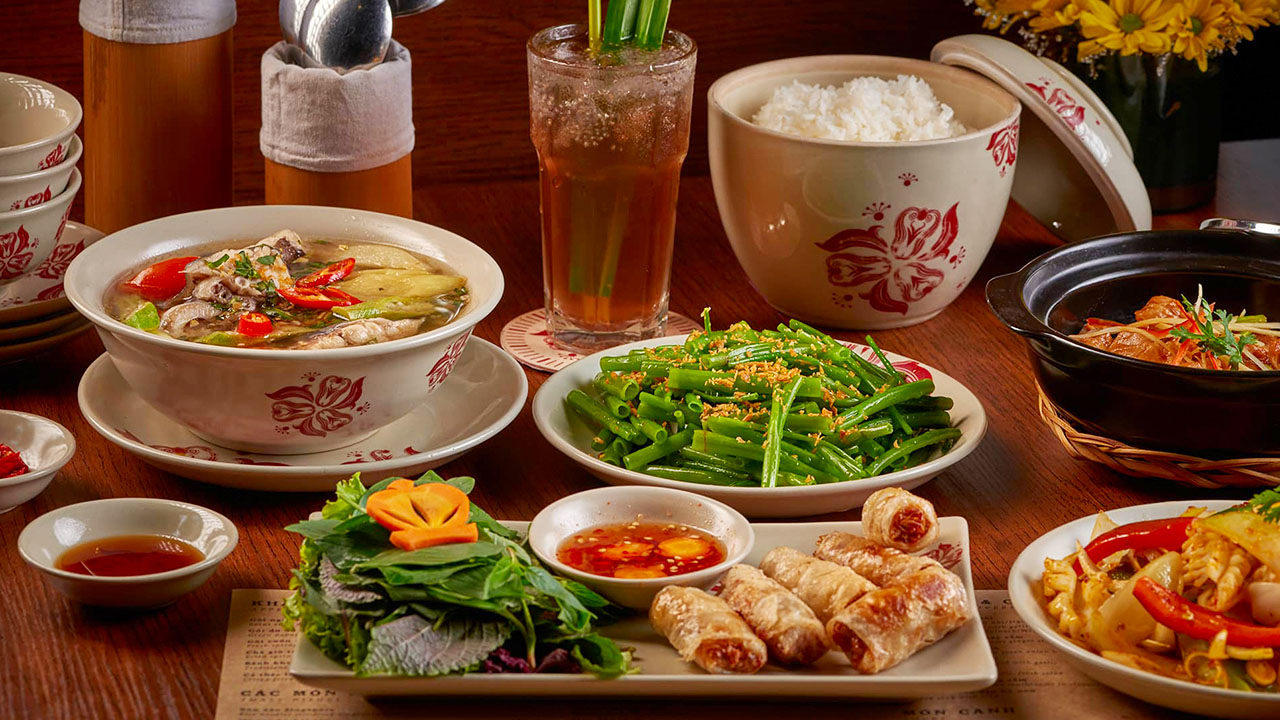
Pho as a Breakfast Staple
At dawn, as Vietnam awakens, pho simmers not only as a meal but as tradition and herald of the day. Street-side food stalls and local joints reverberate with chatter under early morning hues, serving pho as an essential breakfast fixture. The steamy bowls offer nourishment, warmth, and an energetic start, cherished by old and young alike.
- Morning Rituals:
- Start of day fuel
- Community hubs
In Vietnamese lore, pho conveys more than sustenance; it embodies unity family members congregate over bowls, laughing and savoring shared moments. Distant relatives connect, and strangers exchange smiles, marking the beginning of new friendships beneath fragrant tendrils of rising steam.
- Symbolic Role:
- Embody unity
- Forge social bonds
Echoing localized culinary preferences, Northern pho’s subtle flavors entice with clarity and simplicity, while Southern pho speaks with richer notes, celebrating culinary diversity in this morning staple. Each iteration offers a flavorful reminder of Vietnam’s diverse tapestry wrapped neatly inside a humble bowl of pho.
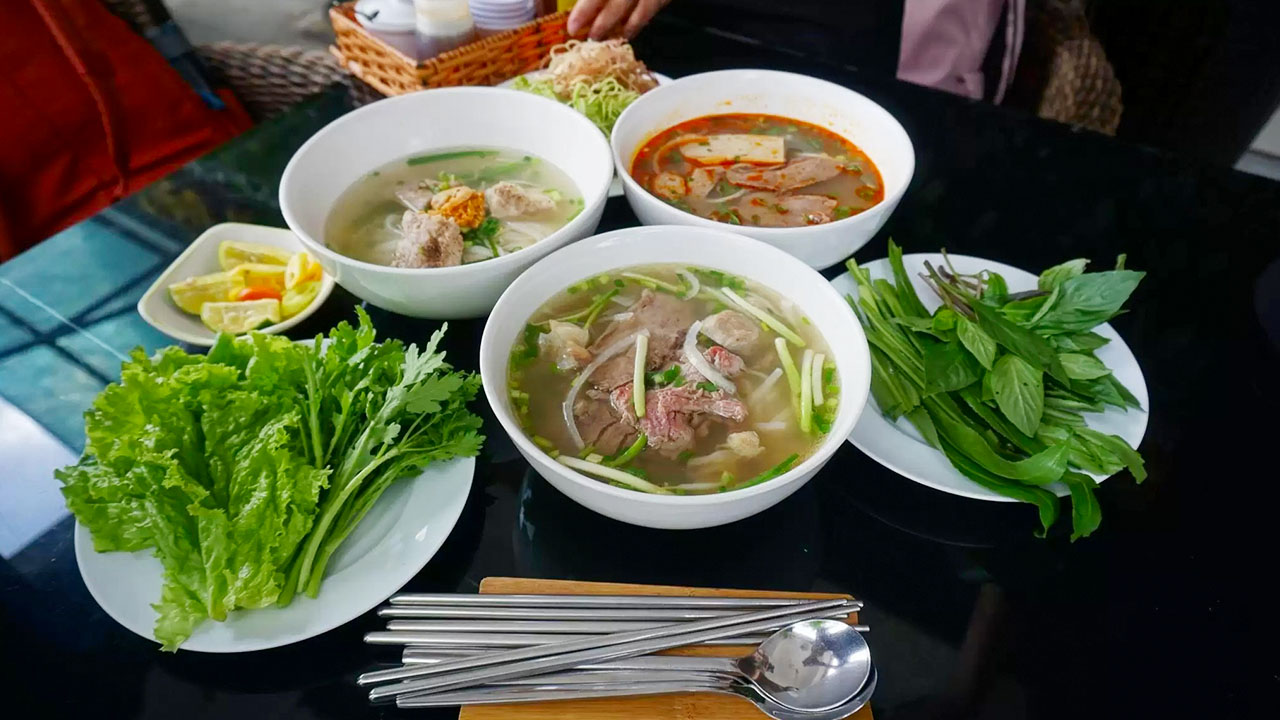
Celebrating Tet With Banh Chung
Tet, the Vietnamese Lunar New Year, presents Banh Chung, not just as a dish, but a tradition woven firmly into each family’s cultural fabric. This square sticky rice cake, infused with mung beans and succulent pork, wrapped delicately in green dong leaves, emerges as an offering of thanksgiving on family altars and dining tables alike.
- Key Ingredients:
- Sticky Rice
- Mung Beans
- Pork
Families gather on New Year’s Eve to prepare Banh Chung, harnessing collective hands and ancestral recipes that transform mere ingredients into embodiments of tradition, agricultural reverence, and familial love. The patient, labor-intensive preparation binds generations visually, fusing bonds among grandparents, parents, and children.
- Symbolism:
- Thanksgiving through offering
- Ancestral recipes
Beyond comfort food, Banh Chung represents prosperity, new beginnings, and the cycle of seasons a declaration of gratitude while summoning reflections on previous blessings and dreams for the coming year. Each bite intertwines Vietnam’s histories and hopes, served with care.

Bun Cha: A Lunchtime Favorite
Around noon in Hanoi, Bun Cha defines lunch not merely as sustenance but an experience. Street corners fill with patrons ready for grilled pork, aromatic rice noodles, and refreshing herbs, unified by sweet-sour nuoc cham dipping sauce, offering gastric satisfaction and social mealtime connections.
Lunch breaks from work or shared moments with family and friends become occasions; Bun Cha’s smoky fate draws in locals and visitors alike, as if the city pulses with anticipation to meet the midday appetite.
- Gastro-social Role:
- Common social mealtime
- Connects locals and visitors alike
From bustling food stalls to home kitchens, Bun Cha’s delicious simplicity is its charm taking form as wraps of zesty joy cherished during lunar celebrations and day-to-day routines. Just a taste cements this dish’s role in Hanoi’s foodscape, providing nourishment and happiness under Vietnam’s afternoon sun.

Special Occasions and Goi Cuon
Goi Cuon, with its medley of meats, noodles, and herbs enclosed in velvety rice paper, flourishes as an enduring tradition at Vietnamese feasts culinary centerpieces that capture freshness and vibrancy. The ritual assembly of Goi Cuon occurs at festive occasions and family gathering tables, inviting interaction, camaraderie, and meditative connection.
Goi Cuon’s adaptability and light profile embody ideal attributes for special times; its freshness complements occasions resonating with liveliness birthdays and anniversaries, or leisurely feasts under Vietnam’s coastal horizons.
- Community and Celebration:
- Foster a sense of communal sharing
- Complements lively occasions
From Tet celebrations to family reunions, Goi Cuon engages not solely as food but as a bridge, uniting those gathered around tables where tradition meets innovation and health meets indulgence. Each spring roll signifies far more than just a snack; it’s part storytelling, part sustenance, and wholly Vietnamese.

Comparisons of Vietnamese Dishes
Vietnamese dishes reveal multi-tiered layers of tradition and innovation, enriched by the nation’s diverse regions and preferences. Iconic staples like pho versus bun bo hue exhibit regional contrasts, while subtle variations in banh mi fillings echo Vietnam’s culinary adaptability. Examining these cross-sections illuminates a shared cultural heritage within their distinct identities, celebrating both unified themes and individual nuances. Through comparing culinary contrasts, the broader narrative of Vietnamese cuisine emerges, typifying the country’s passion for flavor, tradition, and diversity in every bite.

Pho vs. Bun Bo Hue
Both Pho and Bun Bo Hue, iconic noodle soups within Vietnamese cuisine, diverge into rich culinary tapestries, each representing regional uniqueness and crafting an individual experience with every bowl.
Pho, originating from Northern Vietnam, asserts a gentle character, with broth simmered from beef or chicken bones, harmonized through warm spices like star anise and cinnamon. Served with bánh phở noodles, it reflects Vietnam’s subtlety in flavor, delicacy in aroma, and light garnishing with herbs.
- Pho Attributes:
- Mild, savory flavor
- Flat rice noodles
- Herbs and light garnishing
Bun Bo Hue, born in Hue’s central landscape, unearths a robust symphony of flavors lemongrass-laden broth punctuated by shrimp paste heat, balanced with thicker round rice noodles and a medley of pork, beef, or congealed blood cubes that reflect origin’s spice-centric tradition.
- Bun Bo Hue Traits:
- Spicy, intense broth
- Thicker round noodles
- Varied meats and blood cubes
Each soup’s complexity, aroma, and flavor reflects their geographical origins, radiating cultural pride and culinary signature enforce a love narrative within every serving a love of land, legend, and lineage.

Banh Mi vs. Vietnamese Sandwich Variations
Banh Mi, famously marrying French-inspired baguettes with Vietnamese ingredients, sparks creativity through each sandwich variation. While the essence remains constant meats, fresh herbs, and pickles a multitude of interpretations exist, capturing a nation’s adaptive spirit.
The traditional banh mi highlights pork and pickled carrots, but outliers like banh mi chay introduce tofu, aligning with Vietnamese vegetarian culture. Banh mi pate invites richness with liver spread while those dancing on the spicy-sweet boundary opt for hefty chili inclusion to awaken the palate further.
- Elemental Fillings:
- Pork or Chicken for foundational protein
- Pickled Carrots and Daikon for crunch
With myriad regions putting their spin on fillings, banh mi trứng (egg banh mi) emerges, highlighting breakfast or vegetarian features a generation of sandwich exploration that stands alongside the local provision of bánh mì kẹp thịt vịt (duck banh mi).
- Regional Variants:
- Bao buns wrap diverse proteins
- Traditional ingredients fuse with cultural twists
Whether inspired by Hoi An prefecture or Hanoi neighborhoods, banh mi’s lineage speaks a language of integration without boundaries a passport to experiences forged in taste and texture, resonating far beyond Vietnam’s shores.

Goi Cuon vs. Cha Gio: Spring Rolls Comparison
Within Vietnam’s spring roll tradition, Goi Cuon and Cha Gio stand as highly esteemed players, tantalizing taste buds by displaying striking contrasts in ingredients, textures, and preparation forms.
Goi Cuon, the fresh spring roll, wraps fresh vegetables, shrimp or pork, and vermicelli noodles within transparent rice paper, served cold or at room temperature. A crispy-free texture delivers freshness and lightness, accentuated by dipping sauces like peanut or nuoc cham.
- Goi Cuon Highlights:
- Freshly wrapped ingredients
- Light, refreshing taste
- Accompanied by dipping sauces
Cha Gio, meanwhile, delves into a decadent realm, with ground pork or shrimp and vegetables wrapped in wheat paper, then deep-fried. Each slightly crunchy bite mingles warmth and flavor, heightened by nuoc cham on the side a centerpiece for special occasions or treat.
- Cha Gio Marks:
- Fried to crispiness
- Rich, warm, deeper flavor
Comparing both showcases diverse versatile offerings, delighting multiple palettes bound in common yet individually pronounced expressions a testament to Vietnam’s pluralistic gastronomic identity shine in culinary paradigms unique within regional expressions.

Com Tam vs. Other Rice Dishes
The distinction of Com Tam, Vietnam’s beloved broken rice dish, emerges through its unique texture a juxtaposition of soft grains and smoky, flavorsome grilled pork or alternatives top captures a space of its own among rice dishes.
The fractured rice grains offer distinct mouthfeel and soak up vibrant juices from toppings, a culinary testimony not seen in traditional steamed or fried rice, which contain more unified grain structures or heavier oil-based flavors.
- Culinary Distinction:
- Textural delight from broken rice
- Toppings emphasize flavored experience
Com Tam’s standing flourishes amid choices like kho tieu, underscoring sauce-based dark pork, and cơm chiên with diversified ingredients. Where kho presents fusion complexity, and com tam ensures familiarity, each balances savory fulfillment uniquely.
- Concluding Factors:
- Traditional and communal connections
- Simplicity vs. refined structure
Com Tam’s ultimate magic lies in its balance functioning as comfort food or a gourmet canvas exemplifying Vietnam’s architectural excellence in grain and dish diversity, underscoring authenticity, modern simplicity, and perpetual culinary harmony panoramic of the nation’s tastes.

Key Takeaways
- Vietnamese cuisine showcases cultural fusion and tradition, with dishes like pho, banh mi, bun cha, goi cuon, and com tam.
- Each dish reflects regional diversity, adapting flavors while maintaining authenticity.
- Cooking techniques emphasize natural ingredients, focusing on healthy, balanced nutrition.
- Street food vendors play a significant role in Vietnamese culinary culture, providing accessible, flavorful meals.
- Traditional occasions highlight the significance of Vietnamese dishes as cultural symbols and shared experiences.
FAQs
- What makes pho different from other noodle soups?
Pho’s broth is simmered for hours with beef bones, star anise, and herbs, providing a rich, aromatic flavor. - How does banh mi reflect Vietnamese culture?
Banh mi combines a French baguette with Vietnamese ingredients, illustrating cultural fusion and adaptability. - What are the main ingredients in com tam?
Com tam typically includes broken rice, grilled pork, or egg meatloaf, with fresh herbs and pickled vegetables. - Why is goi cuon considered healthy?
Goi cuon incorporates fresh herbs, lean proteins, and vegetables wrapped in rice paper, offering a low-calorie, nutrient-rich option. - What occasions are traditional Vietnamese dishes most significant?
Traditional occasions like Tet or family gatherings highlight dishes, showcasing their cultural and symbolic importance.
Conclusion
Vietnamese cuisine stands as a testament to cultural diversity and culinary artistry, successfully blending history, geography, and flavor into each dish. From the fragrant broth of pho to the crisp crunch of goi cuon, every meal reflects a balance of flavors and textures. The regional variations, cherished during traditional occasions or enjoyed as street food, demonstrate a vibrant gastronomy that continues to captivate global palates. Understanding traditional Vietnamese dishes goes beyond taste it’s about experiencing a living narrative, one interwoven with community, heritage, and an enduring appreciation for life’s simple pleasures. Through each culinary exploration, the soul of Vietnam becomes more vivid, its flavors connecting past, present, and future in shared celebration.


